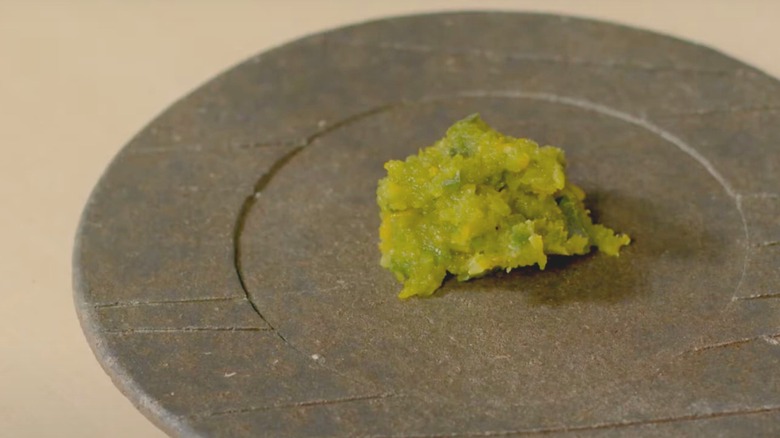Why You Need Yuzu Kosho In Your Ingredient Rotation
If you love Japanese or Korean cuisine, you're probably familiar with yuzu, an Asian citrus fruit that is prominent in both types of cooking. Recently, the fruit (usually, the juice itself) has become more prominent in American restaurants, bars, and bakeries as it's a beautifully nuanced ingredient, described as sour, bitter, sweet, and even floral. Made from the same citrus, yuzu kosho is a condiment that deserves a spot in your kitchen pantry.
Primarily made from the zest of yuzu fruit, yuzu kosho resembles a thick relish or spread and is a powerhouse of flavor. Chili peppers and salt are typically the only other ingredients accompanying the citrus zest to make this condiment. Between its heat, salt, brightness, and umami, yuzu kosho can potentially replace several ingredients you might otherwise need to impart these flavors to a specific dish. Just a small dollop should be enough to flavor an entire recipe.
A robust condiment made with minimal ingredients
Yuzu kosho is made with either the yellow or green zest of the fruit, with the green version being even more robust and flavorful than the yellow. Red or green chili peppers give the condiment its heat, and the salt enhances the flavor of everything. A bit of juice from the yuzu fruit can also be added to create a more cohesive spread, but the result should be fairly thick, like a paste.
The combination of ingredients enlivens almost anything it touches, which is why it's a great seasoning to keep handy. Considering that an open jar stored in the refrigerator will last a very long time, it's not something you need to rush to use up. The flavor and potency of yuzu kosho are strong enough that you only need a tiny bit at a time to impart amazing flavor. That said, a good batch shouldn't be overwhelming in any specific area; the heat should be about medium strength, the zest should be bright but not bitter, and the salt shouldn't be so much that using a little bit would over-salt a dish.
If you are making your own yuzu kosho, which is incredibly simple, you can tailor it to your tastes. If you want more heat, use a hotter pepper than the traditional togarashi Japanese pepper. If you like a bit more sourness, squeeze in some extra yuzu juice.
It's not just for Asian cuisine
When it comes to Japanese and Korean cooking, yuzu kosho can be a fantastic addition to a wide range of dishes. It's a popular condiment for hot pots, brothy soups, sashimi, nigiri, and ramen. Try mixing a bit into a dish of soy sauce for your next sushi meal. However, this exciting accompaniment isn't limited to these types of cuisines. Use it in anything to which you want to add a bit of citrusy heat, like aiolis, which can be spread on sandwiches and hamburgers, or used as dipping sauces. Mix it into marinades for chicken, steak, fish, pork, or shrimp, or use it to make a compound butter for melting over these cooked meats and fish. Stirring a little into fajitas will give the dish a good boost of citrus.
Mix yuzu kosho into a batch of plain rice to liven up the side dish. Incorporate it into salad dressing, add some to sauteed green beans along with toasted slivered almonds, and stir some into your simple chicken noodle soup. You could even use it in pasta; the next time you make your favorite lemon spaghetti recipe, try adding in some yuzu kosho. Top it with some broiled salmon, and perhaps a squeeze of yuzu juice to finish.



